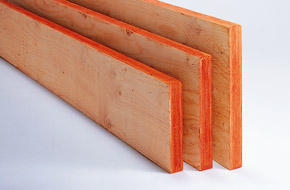A steel I-beam is a type of joist or girder made from steel. I-beams are used as major  support trusses in building, to ensure that a structure will be physically sound. Steel is one of the most common materials used to make I-beams, since it can withstand very heavy loads, although other materials, such as aluminum, are sometimes used. Composite I-beams are also available, with layers of other materials encasing the outside of the steel to disguise it as something else, such as wood.
support trusses in building, to ensure that a structure will be physically sound. Steel is one of the most common materials used to make I-beams, since it can withstand very heavy loads, although other materials, such as aluminum, are sometimes used. Composite I-beams are also available, with layers of other materials encasing the outside of the steel to disguise it as something else, such as wood.
The shape of a steel I-beam strongly resembles a capital “I” in cross section, which explains the name. It has a strong central core capped with flanges on either side. Various lengths of beam are available to suit construction project needs, and each beam also carries a rating, indicating how large it is and how much weight it is able to bear. When engineers are designing a structure, they determine what the load limits of the I-beams used in the structure should be.
Parallam® PSL Columns deliver our highest load capacity.
Parallam PSL columns are strong and consistent. Combine their great load capacity with the  strength of Parallam PSL beams, and longer spans and open floor plans are possible. Parallam PSL columns can be stained or finished for a handsome look in exposed applications. They are an efficient use of wood resources and minimize waste.
strength of Parallam PSL beams, and longer spans and open floor plans are possible. Parallam PSL columns can be stained or finished for a handsome look in exposed applications. They are an efficient use of wood resources and minimize waste.
Parallam PSL delivers on a host of fronts. Our manufacturing process uses veneer strands, allowing a significant percentage of each log to become a high-grade structural member.
For more information about product availability in your region, contact your local Trus Joist representative.
Laminated Veneer Lumber (LVL) is a high-strength engineered wood product used primarily for  structural applications. It is comparable in strength to solid timber, concrete and steel and is manufactured by bonding together rotary peeled or sliced thin wood veneers under heat and pressure. LVL was developed in the 1970s and is today used for permanent structural applications including beams, lintels, purlins, truss chords and formwork. LVL can be used wherever sawn timber is used however one of the main advantages is that it can be manufactured to almost any length, restricted only by transportation to site.
structural applications. It is comparable in strength to solid timber, concrete and steel and is manufactured by bonding together rotary peeled or sliced thin wood veneers under heat and pressure. LVL was developed in the 1970s and is today used for permanent structural applications including beams, lintels, purlins, truss chords and formwork. LVL can be used wherever sawn timber is used however one of the main advantages is that it can be manufactured to almost any length, restricted only by transportation to site.
Prior to lamination, the veneers are dried and the grains of each veneer are oriented in the same direction. This makes LVL stronger, straighter and more uniform than solid timber and overcomes some of timber’s natural limitations such as strength-reducing knots. This gives orthotropic properties (different mechanical properties against different axes) in a similar way to the properties of sawn timber, rather than the isotropic properties (the same mechanical properties in each direction) in the plane of plywood. The added durability of being an engineered wood product means LVL is less prone to shrinking or warping. LVL can also support heavier loads and span longer distances than normal timber.
Section sizes are then cut from 1200 m wide sheets or “billets”. The ability to cut different shapes from the LVL sheets allows for structural innovation using angular and curved shapes.
LVL provides a cost-effective and sustainable building material, delivering high structural reliability and strength.
Note: Some LVL members can be made with a few laminations laid up at right angles to enhance the shear strength of the member. These are known as Cross-Banded LVLs and may need to be specially ordered, as it is not a commonly stocked item.
 support trusses in building, to ensure that a structure will be physically sound. Steel is one of the most common materials used to make I-beams, since it can withstand very heavy loads, although other materials, such as aluminum, are sometimes used. Composite I-beams are also available, with layers of other materials encasing the outside of the steel to disguise it as something else, such as wood.
support trusses in building, to ensure that a structure will be physically sound. Steel is one of the most common materials used to make I-beams, since it can withstand very heavy loads, although other materials, such as aluminum, are sometimes used. Composite I-beams are also available, with layers of other materials encasing the outside of the steel to disguise it as something else, such as wood. strength of Parallam PSL beams, and longer spans and open floor plans are possible. Parallam PSL columns can be stained or finished for a handsome look in exposed applications. They are an efficient use of wood resources and minimize waste.
strength of Parallam PSL beams, and longer spans and open floor plans are possible. Parallam PSL columns can be stained or finished for a handsome look in exposed applications. They are an efficient use of wood resources and minimize waste.